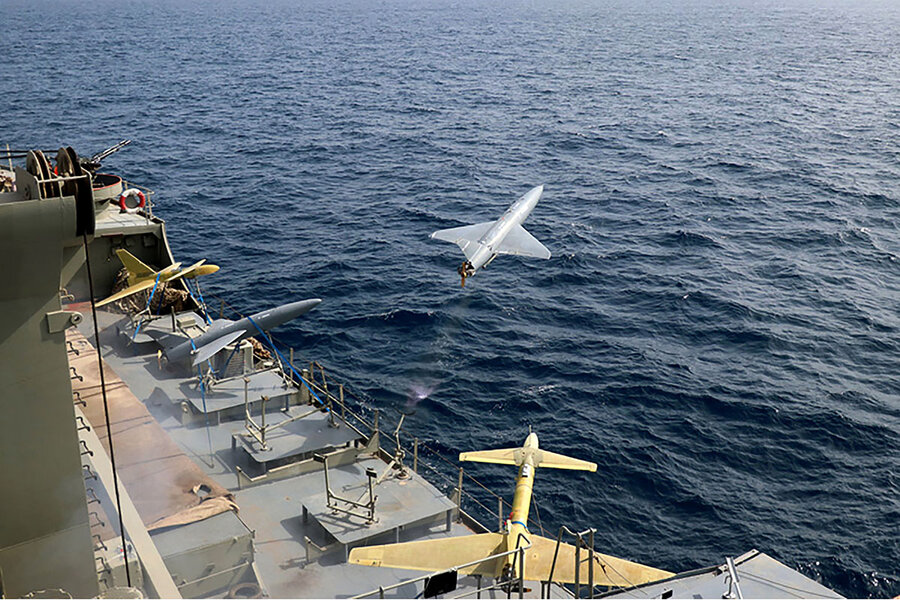Russia has long sold arms to Iran. Now Iran is returning the favor.
Loading...
| Moscow
With the war in Ukraine deepening Russia’s need for immediate sanctions-evading military solutions, Moscow is rapidly ramping up its relations with Iran, particularly through arms deals. And in an unprecedented new feature, the arms trade is two-way, with Iran supplying attack drone technology to Russia.
The two countries have nearly finalized their biggest arms deal in 30 years. Iran is selling drones to Russia, including new models that could greatly improve Russia’s offensive capability in Ukraine. Western reports say that Moscow is also negotiating to buy medium-range ballistic missiles of the new, highly accurate type that Iran has recently been firing at pro-U.S. targets in its own region.
Why We Wrote This
Despite Western perceptions, Iran and Russia are not natural allies, and have generally had a touchy relationship. But that appears to be changing amid Russia’s war in Ukraine and turmoil in the Mideast.
Russia will reportedly supply Iran with its most modern Su-35 fighter planes, submarines, attack helicopters, and jet trainers, at an estimated price tag of $9 billion.
“The relationship between Russia and Iran has grown far more intense than anyone could have imagined a couple of years ago,” says Fyodor Lukyanov, editor of Russia in Global Affairs, a Moscow-based foreign policy journal. “Who would have ever believed that Iran could become a major arms supplier to Russia?”
With the war in Ukraine deepening Russia’s urgent need for weapons untouched by Western sanctions, Moscow is rapidly ramping up its relations with Iran, particularly through arms deals. And, in an unprecedented twist, the arms trade is two-way, with Iran supplying attack drones to Russia.
The two countries have nearly finalized their biggest arms deal in 30 years. Iran is selling drones to Russia that include new models that could greatly improve Russia’s offensive capability in Ukraine. Western reports say that Moscow is also negotiating to buy medium-range ballistic missiles of the new, highly accurate type that Iran has recently been firing at U.S.-linked targets in its own region.
Russia will reportedly supply Iran with its most modern Su-35 fighter planes, submarines, attack helicopters, and jet trainers, at an estimated price tag of $9 billion.
Why We Wrote This
Despite Western perceptions, Iran and Russia are not natural allies, and have generally had a touchy relationship. But that appears to be changing amid Russia’s war in Ukraine and turmoil in the Mideast.
“The relationship between Russia and Iran has grown far more intense than anyone could have imagined a couple of years ago,” says Fyodor Lukyanov, editor of Russia in Global Affairs, a Moscow-based foreign policy journal. “Who would have ever believed that Iran could become a major arms supplier to Russia?”
Though Russia and Iran are often lumped together by Western commentators as natural allies, their relationship has developed cautiously and has often been vexed by significant differences. But Russia’s invasion of Ukraine and turmoil in the Middle East have created mutual needs that are driving a rapid improvement in their ties.
“There is no ideological component to Russo-Iranian relations,” says Andrei Fedorov, a former Russian deputy foreign minister. “It’s purely pragmatic, a bond of ‘brothers in arms’ created by the situation.”
Experts say that Iranian drones, and “swarm” tactics for using them, have helped transform Russia’s early inferiority to Ukraine in drone warfare into a dominant position. Though Russia has no need for ballistic missile expertise, it may be looking for more ammunition than its own factories can produce as it seeks to end the Ukraine war on its own terms.
The two countries have been de facto allies in Syria’s civil war over the past decade, although until recently Russia maintained good relations with Tel Aviv and looked the other way when Israel attacked Iranian assets inside Syria. Experts say that Russia still doesn’t want to abandon its relations with Israel, which have come under growing strain since the beginning of the war in Gaza.
“Neither Russia nor Iran are interested in a big war in the Middle East,” says Mr. Lukyanov. “Despite what they sometimes say, the Iranians are behaving quite cautiously, and the hope in Moscow is that things will not get out of hand.”
The economic ties go well beyond military hardware, with Iranian consumer goods, food products, and even automobiles making their appearance in Russian markets for the first time. In the longer term, the long-discussed North-South Transport Corridor, which would link Iran’s Indian Ocean ports with Russia’s sprawling railway system, is seeing real investment for the first time and could become a reality within five years, says Mr. Fedorov.
“Russia’s view of Iran is that it must be a key part of the post-crisis architecture of the Middle East,” he says. “Russian diplomacy works to that end.”









